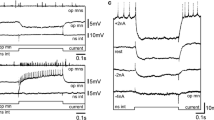Summary
-
1.
The clavate receptor-to-interneuron system of the cricket,Acheta domesticus, was investigated physiologically and morphologically.
-
2.
Intracellular recordings made during controlled displacements of the cricket's cerci allowed the identification of a pair of position sensitive interneurons (PSIs). Changes in the position of the cerci resulted in modulation of the membrane potential and altered the action potential frequency recorded from the PSIs (Fig. 2).
-
3.
Subsequent dye injection demonstrated that the PSIs were a bilaterally symmetric pair of interneurons that received their primary afferent input from club-shaped receptors, called clavate hairs (Fig. 1). The somata of the PSIs are located at the anterior edge of the terminal abdominal ganglion (Fig. 1 C), and the axons are located dorsolaterally in the connectives (Fig. 1 E).
-
4.
Receptive fields for the interneurons were determined by recording the extracellular neural activity from the ventral nerve cord while simultaneously displacing the animal in various orientations. The PSI receptive fields were essentially mirror images, each predominantly occupying one quadrant when plotted in polar coordinates. The receptive fields for the left and right PSIs occupy the left posterior and right posterior quadrants respectively (Fig. 5).
-
5.
Selective deletion of clavate hairs revealed that receptors located in the proximal, medial region of the clavate array provided the strongest input to the ipsilateral interneuron (Fig. 6).
-
6.
Clavate sensory neuron terminal arborizations were stained in order to examine their relationship with the dendrites of the PSIs (Fig. 7).
Similar content being viewed by others
Abbreviations
- PSI :
-
position sensitive interneuron
- MGI :
-
medial giant interneuron
- LGI :
-
lateral giant interneuron
References
Bacon JP, Altman JS (1977) A silver intensification method for cobalt filled neurones in whole mount preparations. Brain Res 138:359–363
Bacon JP, Murphey RK (1981) Cricket cereal filiform hairs have a somatotopic projection in the terminal ganglion. Neurosci Abstr 7:4
Bischof HJ (1975) Die keulenförmigen Sensilla auf den Cerci der GrilleGryllus bimaculatus als Schwerereceptoren. J Comp Physiol 98:277–288
Burrows M (1980) The control of sets of motoneurones by local interneurones in the locust. J Physiol 298:213–233
Callec JJ, Guillet JC, Pichon Y, Boistel J (1971) Further studies on synaptic transmission in insects. II. Relations between sensory information and its synaptic integration at the level of a single giant axon in the cockroach. J Exp Biol 55:123–149
Edwards JS, Palka J (1974) The cerci and abdominal giant fibres of the house cricketAcheta domesticus. I. Anatomy and physiology of normal adults. Proc R Soc Lond [Biol] 185:83–103
Fraenkel SG, Gunn DL (1961) The orientation of animals (Kineses, taxes and compass reactions). Dover Publications, New York
Glantz RM, Kirk M, Viancour T (1981) Interneurons of the crayfish brain: The relationship between dendrite location and afferent input. J Neurobiol 12:311–328
Gregory G (1964) Neuroanatomy of the mesothoracic ganglion of the cockroachPeriplaneta americana (L.). I. The roots of the peripheral nerves. Philos Trans R Soc Lond [Biol] 267:421–465
Hartman HB, Walthall WW, Bennett L, Stewart RR (1979) Giant interneurons mediating equilibrium reception in an insect. Science 205:503–505
Levine RB, Murphey RK (1980) Pre- and postsynaptic inhibition of identified giant interneurons in the cricket (Acheta domesticus). J Comp Physiol 135:269–282
Markl H (1971) Proprioceptive gravity perception in Hymenoptera. In: Gordon SA, Cohen MJ (eds) Gravity and the organism. Chicago University Press, Chicago, pp 185–194
Matsumoto SG, Murphey RK (1977) The cercus-to-giant interneuron system of crickets. IV. Patterns of connectivity between receptors and the medial giant interneuron. J Comp Physiol 119:319–330
Murphey RK (1981) The structure and development of a somatotopic map in crickets: The cereal afferent projection. Dev Biol 88:236–246
Murphey RK, Levine RB (1980) Mechanisms responsible for changes observed in response properties of partially deafferented insect interneurons. J Neurophysiol 43:367–382
Murphey RK, Palka J (1974) Efferent control of cricket giant fibres. Nature 248:249–251
Murphey RK, Palka J, Hustert R (1977) The cercus-to-giant interneuron system of crickets. II. Response characteristics of two giant interneurons. J Comp Physiol 119:285–300
Murphey RK, Jacklet A, Schuster L (1980) A topographic map of sensory cell terminal arborizations in the cricket CNS: Correlation with birthday and position in a sensory array. J Comp Neurol 191:53–64
Palka JM, Olberg RM (1977) The cercus-to-giant interneuron system of crickets. III. Receptive field organization. J Comp Physiol 119:301–317
Palka J, Levine R, Schubiger M (1977) The cercus-to-giant interneuron system of crickets. I. Some attributes of the sensory cells. J Comp Physiol 119:267–283
Pipa RL, Cook EF (1959) Studies on the hexapod nervous system. I. The peripheral distribution of the thoracic nerves of the adult cockroach,Periplaneta americana (L.). Ann Entomol Soc Am 50:695–710
Rayport SG, Kandel ER (1981) Developmental modulation of an electrical synapse: Functional uncoupling. J Neurophysiol 44:555–567
Roth LM, Slifer EH (1973) Spheroid sense organs on the cerci of polyphagiad cockroaches (Blattaria: Polyphagidae). Int J Morphol Embryol 2:13–24
Sakaguchi DS, Murphey RK (1981) Synaptic interactions between the clavate sensory neurons of crickets and an identified interneuron. Neurosci Abstr 7:4
Takeda K, Kennedy D (1964) Soma potentials and modes of activation of crayfish motoneurons. J Cell Comp Physiol 64:165–182
Tobias M, Murphey RK (1979) The response of cereal receptors and identified interneurons in the cricket (Acheta domesticus) to air streams. J Comp Physiol 129:51–59
Walthall WW, Hartman HB (1981) Receptors and giant interneurons signaling gravity orientation information in the cockroachArenivaga. J Comp Physiol 142:359–369
Author information
Authors and Affiliations
Additional information
A preliminary report of this work has been published (Sakaguchi and Murphey 1981)
Rights and permissions
About this article
Cite this article
Sakaguchi, D.S., Murphey, R.K. The equilibrium detecting system of the cricket: Physiology and morphology of an identified interneuron. J. Comp. Physiol. 150, 141–152 (1983). https://doi.org/10.1007/BF00606364
Accepted:
Issue Date:
DOI: https://doi.org/10.1007/BF00606364




